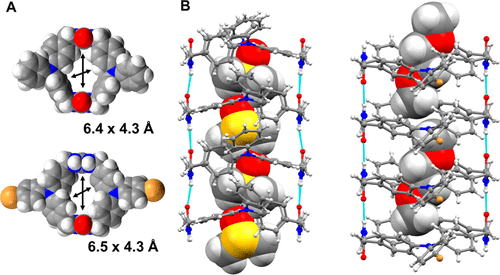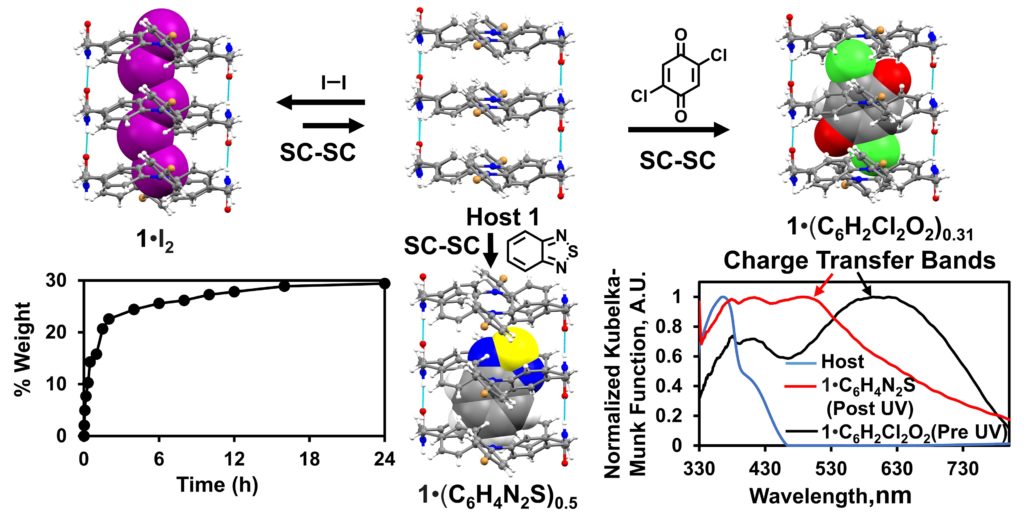Research
Research Summary
The general focus of our research is designing small molecules that can assemble in high fidelity to give functional materials. In particular, we are interested in how assembly affects the photophysical properties of these compounds as well as how the assembly process can form new accessible spaces including columns and pores. Areas of interest include porous organic crystals, hydrogen-bonded organic frameworks, photochemistry, supramolecular chemistry, and medicinal chemistry.
Research Areas
Functional materials from bis-urea macrocycles
Nature employs self-assembly approaches to control the size and shape of biological structures for performing specific functions. Examples include protein channels and enzymes. A protein channel is formed by a protein that folds into a hollow tubular structure and spans across a membrane to allow the passage of small molecules or ions from one side of a membrane to the other side through the channel. An enzyme is a protein that folds into a 3-dimensional structure to create a pocket of specific size and shape for binding and converting target molecules into desired chemical products. Inspired by Nature, our group makes small donut-shaped molecules that assemble in high fidelity into straw-like structures called nanotubes. These nanotubes have tiny 1-dimensional channels of less than a nanometer (about 1/1000 times the width of a strand of hair) in diameter. Our group conducts research to understand how gases and small molecules are organized and move through these tiny channels. We also use these nanotubes to restrict how molecules in these channels are oriented with respect to one another, which alters how these trapped guests can react. In particular, we are exploring photooxidations, photocycloadditions, and polymerizations within these channels.

Exploring Methods to Control the Growth of Nanotubular Assemblies in Solution
We are interested in exploring methods to make precise nanoscale assemblies that range from between three to 150 molecules. The goal is to create a series of ‘molecular rulers’ between 1 to 50 nanometers in length to bridge the gap between single molecules and supramolecular polymers. Our strategies to control the size of these nanotubular assemblies include frustrating their growth by attaching large groups on the exterior of the macrocycles, using chain-stopping monomers to halt the growth of the nanotubes, and adding guests and templates that can be encapsulated within the nanotubular assemblies to stabilize stacks of specific size. Precise control of assemblies in this size has the potential to be transformative, opening new opportunities to understand chemical, light-driven, and electron transfer processes that occur over these length scales.

Photoinduced Electron Transfer in Organized Donor: Acceptor Assemblies
Bis-urea macrocycles and linear analogs that contain triphenylamines (TPAs) are particularly interesting as model systems for probing the effects of organization on photoinduced electron transfer. Substituted TPAs are of great interest for sensing, as two-photon absorbers and in organic light-emitting diodes. They have a low-lying HOMO and are excellent one-electron donors. The TPA radical cations also show potential as oxidants and have been used as cathodes in batteries and incorporated into polymers as spin-containing units. Here, we control their assembly into columnar structures to afford accessible channels with walls that contain the TPA units. These materials give robust crystals, which exchange guests in a single-crystal to single-crystal process. We are currently loading in guests that are suitable electron acceptors based on their reduction potentials and their size and shape relative to the channel dimensions. Macrocycles can be assembled into films or those with exterior solubilizing groups can be organized into nanotubes in solution. Our goal is to probe the effect of confinement on both the forward and reverse electron transfer and to investigate the charge-separated states in host:guest complexes in each type of assembly (films, nanotubes, and crystals).

Novel Therapeutics Targeting LY6K
Dr. Upadhyay and her group at Uniformed Services are working to understand the mechanistic role of cancer biomarkers in tumor progression and test their applicability in the treatment of triple-negative breast cancer. We are collaborating with the Upadhyay group and Dr. Maksymilian Chruszcz at UofSC to develop new compounds that target Lymphocyte antigen-6 genes and in particular, the cell surface protein LY6K. This protein is required for transforming growth factor-beta and interferon-gamma signaling specific to triple-negative breast cancer.